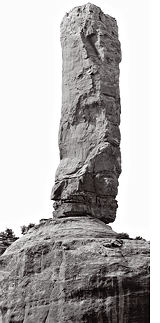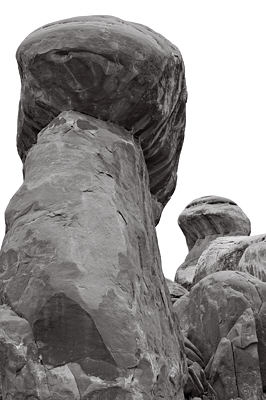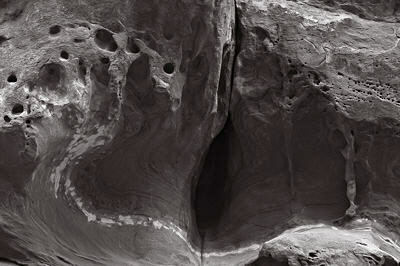 Sure the title is a pun I couldn’t resist, but it’s also the lead-in to a serious question about art and perception. It arose in the context of a photography trip to Utah last April, which began in Arches National Park. A few weeks ago, in Bones of the Earth, I made my first post about the project with that tentative title, which comes from the impression that the exposed rocks represent structures normally below the skin of the Earth.
Sure the title is a pun I couldn’t resist, but it’s also the lead-in to a serious question about art and perception. It arose in the context of a photography trip to Utah last April, which began in Arches National Park. A few weeks ago, in Bones of the Earth, I made my first post about the project with that tentative title, which comes from the impression that the exposed rocks represent structures normally below the skin of the Earth.
The rock formations in Arches and elsewhere are of many shapes. Among them are ones that can’t help but bring the word phallic to mind. The first picture I took that first morning (first image below) already fit into that category. That’s not why I made the photograph — at least not consciously — but it’s something that occurred to me at roughly the same moment I decided to set up the camera. And although the rock can certainly stand on its own as subject, it’s possible that the subliminal association helped draw my attention to it.


After wandering through the area and making a number of photographs along similar lines, I was beginning to wonder if this had to be considered an exclusively male landscape. Very shortly after that, the following rock caught my attention, though I think it took a few moments to figure out why.

That turned out to be the first of many, so perhaps this landscape was not so gender-skewed after all. But if anything, it underlined the question of how much our attention, whether considering a landscape or an artwork, might be directed by sexual associations, unconscious or not. This is not unlike the face recognition discussed in a previous post, where it is well known that the brain has special regions for the task. I suspect that with abstract art, where obvious subjects are missing or minimal, this kind of subliminal processing has a much stronger affect.
Have there been times when sexual associations played a role in either your art or your viewing of someone else’s art? Are there artists, abstract or realistic, who deliberately manipulate our reactions using such perceptual tendencies? I guess one example, at least, is Edward Weston’s gorgeous pepper.

Steve,
My textile work, “Miocene,” evoked a lot of questions/comments from the others in the master class where I first began working the cloth. Vulva’s as well as ram’s heads and even, from the instructor, a pile of excrement, became part of the discourse about the piece. I loved the discussion — I too has seen, at the moment that I finished the first cut that there were gender/sexual elements potentials and I consciously kept them there.
Because I was working on some idea of the fecundity of the earth, the bringing forth of all foolish and sometimes long extinct life, the sexual elements make perfect sense. The temporal nature of sexuality and individual lives against the permanency of sexuality and life itself — some such notions as that —
I suspect that the connection between what you have shown us here and “Miocene” is our communal consciousness of the sexual, and our deliberate inclusion of it in our imagery.
It doesn’t surprise me that we see the sexual/gendered imagery — the question, I suppose, is if we insist on it as part of our art, what are we to make of it? Itcan scarcely have shock value nowadays; and I don’t see that the idea of sex has anything to do with your art — that is, the shapes of rocks are pretty random and our visions are always randy, but finally, I see only an imposition of a human preoccupation on a totally indifferent element. The rocks are far more interesting to me as texture and abstraction than as sexual objects because I can’t find any other connections to sexuality or any ideas of it that you are exploring. The interest could, I suppose, lie in my own reactions, but even there, I find it rather boring to be focused on the titillation. I’m rather happier being fascinated with the textures (particularly of the last two photos) and with the viewpoint from which we are looking at the rocks. The last (female) photo has a weird angle with the slit in the rocks facing away from us that makes me slightly uneasy — not in a sexual sense, but in the sense of a physical orientation to such obdurate objects. The photo has such lovely curves, such slippery surfaces revealed, and then puts the viewer at a precarious angle to them. That interests me (and as I say it, I suppose one could insist that that’s the sexual point…….)
Or maybe I’m just too jaded.
I too have such associations. The exposed roots where sand is blown off a dune remind my of genital hair.
And, Georgia O’Keefe comes to mind.
Your pictures are lovely – the mechanics of balancing one huge rock on another and, in the last picture, the dancing curves sculpted by the elements.
Steve,
It is funny-sad to think of traveling so far to such an awe-inspiring and beautiful place and be left with this ridiculously infertile perspective. I am sort of shocked.
D,
Why do you think the connotation of sex in these rocks is a “ridiculously infertile perspective”? I would be interested in your thoughts…
Given the surfeit of sexual imagery with which one is accosted with in the modern world, I thought it was a natural extension to see rocks (especially rocks thus shaped) in this additional perspective.
The modern human being’s brain is slowly being wired to increasingly only see the ‘sexy’ side of things… (the brain is readjusting itself in a response to the stimulus from the environment we are exposed to and live in). You hear sex all the time – in fact the other day I remember my boss asking me if the PowerPoint presentation was sexy enough… (When all it contained was growth predictions and population influx patterns for NYC) – it is just a way of life now…
June,
Yes, I think the sexual associations are very appropriate in your work. It feels like more of a distraction in my case, but perhaps as I go along I’ll enlarge my perspective. My current feeling is more that this is a sterile environment; the rocks/bones are bare and bleached, like animal bones I often come across here.
Birgit,
Thank you for mentioning O’Keefe! I’ll have to go look at some of her paintings of both bones and desert. I do recall learning that she always denied intending any sexual connotations of her flowers, which everyone took as a major reading.
D.,
I fear you misunderstand me. The sexual associations are not my “take” on the rocks, nor do I think that has much to do with my interest in them. I’d say my primary goal is to explore the concept of the rocks as bone-like structures — though how that will work out, I really don’t know yet. However, I do think that such associations may have had something to do with what I noticed, and also with the reactions of others to some of the photographs. I could try to ignore that, but I’m not sure why I should.
Steve,
I don’t have an affinity for Georgia O’Keefe’s flowers.
But I have a book (not with me) that shows her pictures of rock formations in NM. I see many of them as highly sexual.
Of course, she would deny an intent to show symbolic genitalia. It was a different age back then.
I had a prof who used to say that in art, anything longer than it is wide is a phallic symbol. hmmm. Seems kind of limiting to me. And a distraction for your work too, Steve. Tell the truth, you wanted people googling “sex” to find your post, didn’t you? :)
Leslie,
Well, I think orientation also matters. I agree it’s terribly limiting if such are the only terms in which one can see things. But I can also imagine that it might lead to an interesting overlayer of emotional content if handled in the right way. That’s not my goal, but I want to be aware of it.
Since you bring up search engines, I checked and found that 1.6% of the searches that bring people to A&P contain the word “sex” (and almost all have “painting” or “drawing” as well). It doesn’t seem a huge audience to go after, but on the other hand maybe they’re more willing to part with money. I hereby promise to donate proceeds from any sales of these photos initiated through such a search to a charity of your choice. I’ll let you know when you need to start thinking about one. :)
Sunil,
They are rocks in southern Utah. Hoodoos?
Although Sex Culture seems to be Everywhere, it does not need to be. What was your response to your boss? Did you give him the benefit of the doubt or just forgive him for having a modern brain?
Steve,
I am not certain if I understand our misunderstanding. Do these rocks really look like erect penises? And further, why are you so interested in Our responses when you seem so uncertain of Your own?
Apologies for being blunt but I also sense an Underlayer of Web Traffic. Oh well.
Do these rocks really look like erect penises?
No, but they can bring that to mind willy-nilly. These are not symbols deliberately employed by geology or by me, but I think ignoring the inevitable associations is a tad silly. As an artist figuring out my own feelings about this landscape and how to represent it (this is still early work in progress, years from a portfolio), this is something I want to think about. Since it will not exist in a cultural vacuum, I’m curious what other people think about it, too. I’d rather engage than pronounce. If that comes across as a lack of artistic backbone, well, sorry about that. That’s just not how I see it.
I also sense an Underlayer of Web Traffic
I admit I’m slightly curious about the reaction to a provocative title (looks like a big yawn so far), but it was more for play than anything. Maybe I should have gone with “Potential suggestive symbolism in eroded mid-Jurassic sandstone”. Hmmm, it’s tempting to change it, but it’s longer than I like for the right sidebar. I bet it would get more hits, though.
Steve:
If you had been photographing June’s John Day Fossil Beds, then we might postulate a Bronto on Viagra – perhaps from the Obcene period.
Hard to say if anything of mine has come across as sexually charged. I do know that cloths have been urgently draped over my work to protect the innocent.
Perhaps the deity is often considered as male because worshipers insist of poking long slender devotional things, like steeples, in “his” general direction.
Sunil:
Population influx patterns? For shame!
Steve,
C’mon.
“Sex” because we don’t live in a Cultural Vacuum? And: “…more for play than anything”? No wonder my mis-misunderstanding.
This thread reminds me of my post Whiffs of North American Modesty
D.,
Sorry, the “it [work of mine] will not exist in a cultural vacuum” was meant as a response to your question “why are you so interested in Our responses”? No doubt there are artists who don’t care what other people think of their work, but I do to a certain extent. I am interested in how they think about it, what strikes them about it, more than whether they like it or not.
By the way, I sent the third image to Sunil to see what he might do with it, and he came up with something utterly different, which I’ll post about soon. That was without saying a word, so it will be interesting to hear about how he viewed the image. [Sunil, feel free to respond now if you want, or save it for the later post.]
Steve,
But I want to know WHAT YOU THINK.
“I had a prof who used to say that in art, anything longer than it is wide is a phallic symbol. hmmm. Seems kind of limiting to me.”
i had a prof who said the same sort of thing, ‘anything taller than it is wide is a phallic symbol’ but added ‘anything wider than it is tall is a phallic symbol on its side’
THAT was limiting.
D.,
I guess the best statement of my current thinking is in the photographs as they are presented now — with the proviso that this work is very early and very much in flux. I’m still considering presenting them as negatives, but as I mentioned, I expect a “final” version of the project is at least a year off. That positive/negative reversal is an example of a change that would dramatically affect a viewer’s perception. I suspect that the kind of sexual connotations we’ve been discussing would be less likely to arise, and if they did they would have less force, more intellectual observations (shape statements as Leslie and dave mentioned) than felt strength.
I certainly think some of the sense of strength or vigor in, say, #3, comes from its shape and upward thrust, and I think some fraction of that is enhanced by the allusion. But I’ve actually tried to downplay that association by the cropping (different from the previous post) which nearly makes the central rock into an abstract rectangular block with just a hint of its actual shape. On the other hand, I tinted all of these slightly reddish, which fits the actual color of the stone but is also reminiscent of flesh (it’s the same tint I used on the recent waterfalls, for different reasons).
You seem to be asking me for a definitive statement on this subject, but I don’t think I have one — especially at this point — and I don’t think I even want one. I just updated my post about my artist’s statement with my final version, written last week. Imperfect though it is, it does express two elements relevant to this discussion: 1) for me, photography is exploratory, the way I grapple with issues like the present one (how I feel about this landscape); 2) I am interested in allusions that engage the viewer. I should add that discussions on A&P are sometimes a part of my grappling.
I’m not sure if that answers you exactly, but that is what I think at the moment. I emphasize again that it not only is provisional, it feels provisional.
Steve,
I am not asking you “for a definitive statement”. I simply wish to encourage a level of Conviction that resists the Temptation of an easy read. Perhaps I am over-reacting to the cultural prevalence of Whatever.
Conviction is a good word. In my opinion, these photographs are lacking it.
Steve,
I think that the second and third images are cropped too tightly.
Birgit,
The cropping is an experiment, and I like it somewhat on #3, not on #2. Mainly, I need to do better framing on location next time I’m there. Even though the general concept of the project came to me right away, my understanding of what I want in order to make it work is certainly still evolving.
Steve,
I am looking forward to new expansive and cropped views of rock formations in Arches and elsewhere. Sex Rocks II.
Unlimited opportunities of perspectives in different lights!
Steve,
Have you been to Goblin Valley?
I know of it, but haven’t been yet. Passed within a few miles of there last trip, but didn’t have the time. Hopefully next trip…